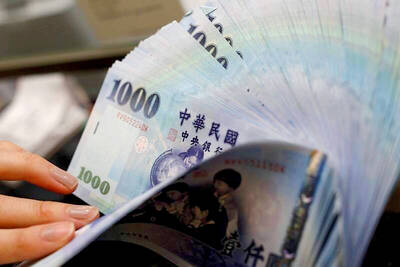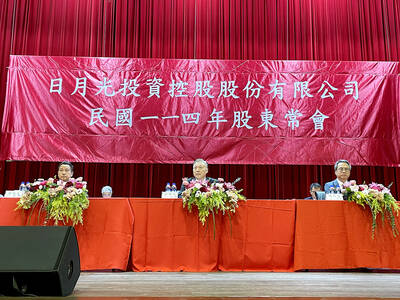BenQ Corp (
"The market has seen a stock accumulation of LCD monitors of as much as 200,000 units," said Danny Yao (
Yao attributed the higher inventory levels to slow market demand in the second quarter caused by political uncertainty and a sluggish stock market.
As BenQ's stock level remained lower than that of its rivals, the price cut would not have a huge impact, Yao said.
"We hope the move could boost our market share [in Taiwan] to 30 percent in the third quarter from the current level of about 20 percent to 22 percent," he said.
BenQ reduced the prices of its LCD monitors by around 15 percent to 20 percent. The price of a regular 17-inch LCD monitor, for example, dropped to between NT$11,900 and NT$14,800 from the original range of NT$13,900 to NT$16,800.
Yao denied that the price cut was bolstered by special discounts from BenQ's LCD panel supplier AU Optronics Corp (
Expecting a bright future for larger monitors, BenQ also reduced the prices of its 19-inch products to below NT$20,000 per unit, hoping to seize half of the market for 19-inch monitors by the end of this year. The 19-inch monitor market could make up 15 percent of the nation's total LCD monitor market, up from the current level of 7 percent, Yao said.
The local market is expected to absorb around 1.2 million LCD models this year. BenQ, which saw sales of around 124,000 units in the first half of the year, hopes to market up to 320,000 units in Taiwan this year, according to BenQ Asia Pacific's marketing specialist Derrick Tseng (
BenQ's smaller rival View Sonic International Corp said that, unlike BenQ, it had healthy stock levels and would not join in the throat-cutting price competition anytime soon.
ViewSonic would not launch promotions targeting the commercial and retail markets until the middle of next month, said Alan Chang (
Chang said that the company's sales of LCD monitors in the first half of this year grew by up to 8 percent from a year ago. ViewSonic expects to sell 300,000 units in Taiwan this year.
A total of 239,167 LCD monitors were sold locally in the first quarter, according to statistics by International Data Corp.
BenQ and ViewSonic were the two leading brands, followed by Chi Mei Optoelectronics Corp's (

Merida Industry Co (美利達) has seen signs of recovery in the US and European markets this year, as customers are gradually depleting their inventories, the bicycle maker told shareholders yesterday. Given robust growth in new orders at its Taiwanese factory, coupled with its subsidiaries’ improving performance, Merida said it remains confident about the bicycle market’s prospects and expects steady growth in its core business this year. CAUTION ON CHINA However, the company must handle the Chinese market with great caution, as sales of road bikes there have declined significantly, affecting its revenue and profitability, Merida said in a statement, adding that it would

RISING: Strong exports, and life insurance companies’ efforts to manage currency risks indicates the NT dollar would eventually pass the 29 level, an expert said The New Taiwan dollar yesterday rallied to its strongest in three years amid inflows to the nation’s stock market and broad-based weakness in the US dollar. Exporter sales of the US currency and a repatriation of funds from local asset managers also played a role, said two traders, who asked not to be identified as they were not authorized to speak publicly. State-owned banks were seen buying the greenback yesterday, but only at a moderate scale, the traders said. The local currency gained 0.77 percent, outperforming almost all of its Asian peers, to close at NT$29.165 per US dollar in Taipei trading yesterday. The

RECORD LOW: Global firms’ increased inventories, tariff disputes not yet impacting Taiwan and new graduates not yet entering the market contributed to the decrease Taiwan’s unemployment rate last month dropped to 3.3 percent, the lowest for the month in 25 years, as strong exports and resilient domestic demand boosted hiring across various sectors, the Directorate-General of Budget, Accounting and Statistics (DGBAS) said yesterday. After seasonal adjustments, the jobless rate eased to 3.34 percent, the best performance in 24 years, suggesting a stable labor market, although a mild increase is expected with the graduation season from this month through August, the statistics agency said. “Potential shocks from tariff disputes between the US and China have yet to affect Taiwan’s job market,” Census Department Deputy Director Tan Wen-ling

UNCERTAINTIES: The world’s biggest chip packager and tester is closely monitoring the US’ tariff policy before making any capacity adjustments, a company official said ASE Technology Holding Inc (日月光投控), the world’s biggest chip packager and tester, yesterday said it is cautiously evaluating new advanced packaging capacity expansion in the US in response to customers’ requests amid uncertainties about the US’ tariff policy. Compared with its semiconductor peers, ASE has been relatively prudent about building new capacity in the US. However, the company is adjusting its global manufacturing footprint expansion after US President Donald Trump announced “reciprocal” tariffs in April, and new import duties targeting semiconductors and other items that are vital to national security. ASE subsidiary Siliconware Precision Industries Co (SPIL, 矽品精密) is participating in Nvidia